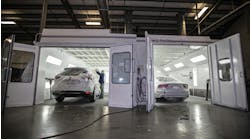Content brought to you by Auto Body Repair Network. To subscribe, click here.
What you'll learn:
- Gain insight about the trials in the collision industry
- Identify the issues that challenge you the most: consolidation, labor rates, rising paint costs and DRP agreements in relation to OEM repair processes
At this past year’s SEMA, I was involved in several discussions, ranging from consolidation to labor rates, paint prices, and insurance company interactions. Some of the conversations were deep, while others were fleeting because of frustration and helplessness. A couple colleagues and I facilitated “The Ebb and Flow of the New Normal” as part of the SCRS Repairer Driven Education series, which opened more opportunity for discussion of the trials we are facing in our industry.
I believe the most reflective discussions were around labor rates. I say “reflective,” because I feel those in the discussion thought about their current rates and why they are what they are. One person remarked, “the insurance companies need to give us a raise,” which opened the door for me to start asking my series of “why” questions to determine why they felt it was the insurance companies’ position to offer a raise. I think that waiting for an insurer to raise labor rates is comparable to standing in front of your collision center waiting for an accident to happen.
Every price in your business should be calculated using your costs multiplied by expected gross profit. Parts, paint, sublet, and, most importantly, labor rates -- should all be calculated based on your costs. I discussed this in depth in a previous ABRN article, Increase Reimbursements by Managing Skillsets, but I will offer a quick recap here. Every skillset in your business has a different cost to maintain, with the lowest being a non-structural technician, and the highest being a structural technician with welding certifications. However, on many of the appraisals I review, most of the repair processes are categorized in the body skillset. When you look at the repair processes for modern vehicles, structural and mechanical skillsets are the primary requirements. When I do see the structural labor category used, the rate is the same as body, which seems odd to me since the cost of training a structural technician is much more than a non-structural technician. When I think about it using this same thought process, it is difficult for me to understand why the paint labor rate is the same as body.
Rising paint costs came at me from several different angles. I agree there have been several price adjustments recently across the different paint brands, but there have been increases in part prices and other items as well. The difference with parts and other items is that you bill from vendor invoices so that you maintain profitability. With paint, many are still following the paint reimbursement-by-refinish hour calculation provided on damage appraisals, and this is where a price increase affects your bottom line. Most paint mixing computer systems have a material invoicing program which can be used to itemize products consumed in the refinishing process. Using these programs to create invoices will allow you to bill just like you would a part. After all, paint is a part, too, just in liquid form.
I believe the most frustration and helplessness I heard was concerning insurance company interactions. “I can’t get an insurer to pay for required steps” and “I get downgraded on my scorecard if I bill for that” were big items of discussion. I understand the frustration, and it is mainly because of trying to satisfy multiple entities. The biggest disparity was with OEM-certified shops trying to gain reimbursement for required OEM processes while staying within DRP metrics. While I won’t go as far as to say that is impossible, I will say that could cause a lot of frustration. I know of shops that have had some success, but the effort behind it was tremendous. When coaching shops, I encourage them to make a choice between DRP agreements and OEM certifications, and I also encourage you to evaluate your own relationships. If a DRP representative is resistant to reimburse you for performing required repairs, I would have to question the value of that arrangement.
I believe that we ourselves bring on some of the trials seen in the collision industry today. I could probably go as far as to say that most of the trials are a result of the practices we have adopted. We have let other entities control our businesses to the point that frustration and helplessness is paramount, which brings me to consolidation. Several individuals I spoke with were either meeting people at SEMA (or would be meeting them once they returned home) about selling their businesses because they have simply had enough. While selling to a consolidator or regional MSO could be the answer for some, I believe that the majority would still like to continue running their businesses but with less frustration.
So, what are we going to do about this frustration? The simple answer: take back control of your business. It’s easy to say, but in reality, I know it is not that simple. The good news is that there are some steps you can take to gain control. I would begin by making an honest list of the things that frustrate you and evaluate each one. This method helps me as well, and I find that some things can be eliminated very easily while others take a little more work. The things that are controlled by other individuals will take some negotiation with those entities. How they react to your discussion will tell you how valuable you are to them and let you to make some important decisions. In the end, I hope you will understand that trying to serve two or more entities brings more frustration than anyone should endure. Making changes to your business that remove frustration is what will allow you to create sustainability and feel more successful. I’m looking forward to a bright 2022 and hope you have gained some new ideas from this article to brighten your future as well.





